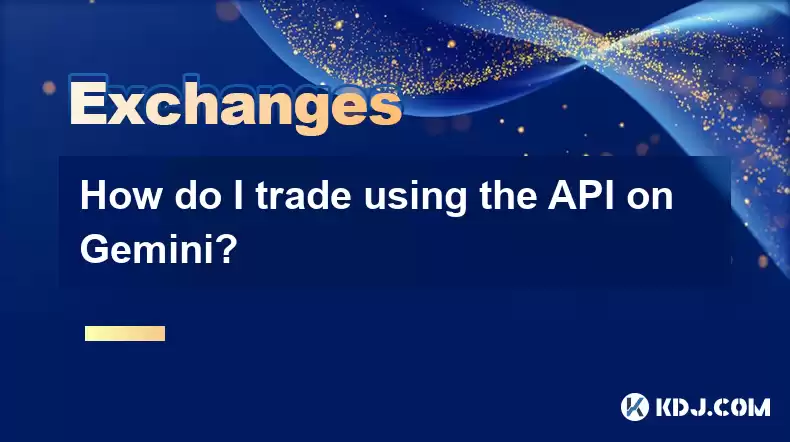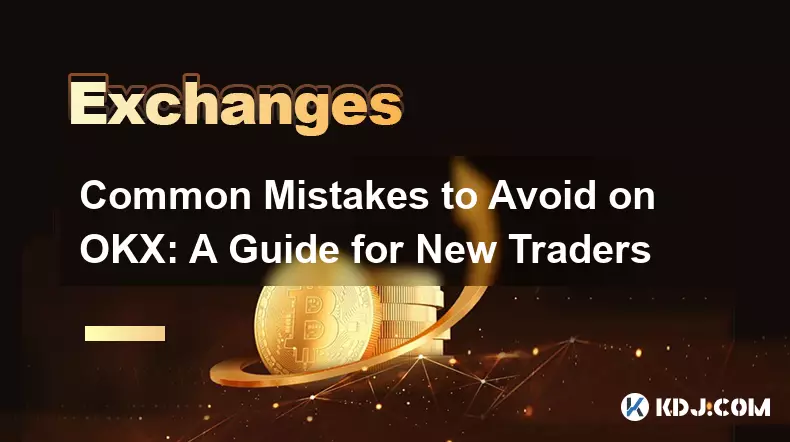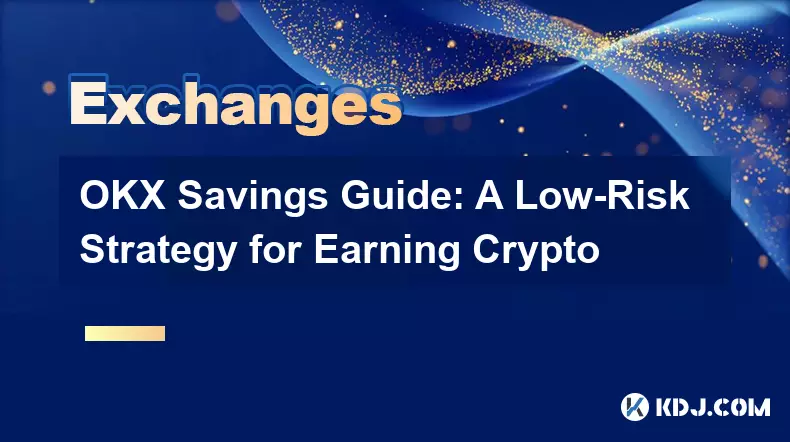-
 bitcoin
bitcoin $105968.894684 USD
4.17% -
 ethereum
ethereum $3639.320047 USD
7.62% -
 tether
tether $1.000339 USD
0.06% -
 xrp
xrp $2.407774 USD
5.96% -
 bnb
bnb $1011.704193 USD
2.28% -
 solana
solana $166.942754 USD
6.37% -
 usd-coin
usd-coin $1.000143 USD
0.03% -
 tron
tron $0.291515 USD
0.25% -
 dogecoin
dogecoin $0.181682 USD
4.06% -
 cardano
cardano $0.585450 USD
4.54% -
 hyperliquid
hyperliquid $42.099968 USD
5.20% -
 chainlink
chainlink $16.160745 USD
5.45% -
 zcash
zcash $645.269648 USD
12.96% -
 bitcoin-cash
bitcoin-cash $507.430338 USD
2.80% -
 stellar
stellar $0.290357 USD
3.69%
How do I trade using the API on Gemini?
To trade on Gemini using the API, set up your account, authenticate requests with your API key and secret, and use endpoints for placing, canceling, and monitoring orders.
Apr 05, 2025 at 09:01 am

Trading using the API on Gemini can be a powerful way to automate your trading strategies and interact with the exchange programmatically. This article will guide you through the process of setting up and using the Gemini API for trading, covering everything from initial setup to executing trades.
Setting Up Your Gemini Account for API Access
Before you can start trading using the API, you need to set up your Gemini account to allow API access. Here's how you can do it:
- Log into your Gemini account. Navigate to the settings or account management section.
- Find the API section. This is usually under the 'Security' or 'API' tab.
- Create a new API key. You will be prompted to name your key and set permissions. For trading, ensure you select the appropriate permissions such as 'Trade' and 'Withdraw'.
- Secure your API key. After creation, you will receive an API key and a secret key. Store these securely, as they grant access to your account.
Understanding Gemini API Endpoints
Gemini provides several API endpoints that you can use for different purposes. For trading, the most relevant endpoints are:
- Order Placement: Used to place new orders on the exchange.
- Order Cancellation: Allows you to cancel existing orders.
- Order Status: Retrieves the status of your orders.
- Account Balances: Checks your current balances on the exchange.
Each endpoint requires specific parameters and returns data in JSON format. Understanding these endpoints is crucial for effective trading.
Preparing Your Trading Environment
To interact with the Gemini API, you'll need to set up a development environment. Here's what you need:
- Choose a programming language. Popular choices include Python, JavaScript, and Java.
- Install necessary libraries. For Python, you might use
requestsfor HTTP requests andhmacfor signing your requests. - Set up your API credentials. Use the API key and secret key you created earlier to authenticate your requests.
Authenticating Your API Requests
Every request to the Gemini API must be authenticated using your API key and secret key. Here's how to do it:
- Generate a nonce. A nonce is a unique number that ensures each request is unique. It can be a timestamp or a counter.
- Create the payload. Combine the nonce with the API endpoint and any parameters you're sending.
- Sign the payload. Use the HMAC-SHA384 algorithm with your secret key to sign the payload.
- Send the request. Include the API key in the headers, the payload in the body, and the signature in the headers.
Here's a basic example in Python:
import timeimport hmacimport hashlibimport requests
api_key = 'your_api_key'api_secret = 'your_api_secret'.encode()
endpoint = '/v1/order/new'payload_nonce = str(int(time.time() * 1000))payload = {
'request': endpoint,
'nonce': payload_nonce,
'symbol': 'btcusd',
'amount': '5',
'price': '35000',
'side': 'buy',
'type': 'exchange limit'
}
encoded_payload = json.dumps(payload).encode()b64 = base64.b64encode(encoded_payload)signature = hmac.new(api_secret, b64, hashlib.sha384).hexdigest()
headers = {
'Content-Type': 'text/plain',
'Content-Length': '0',
'X-GEMINI-APIKEY': api_key,
'X-GEMINI-PAYLOAD': b64.decode(),
'X-GEMINI-SIGNATURE': signature
}
response = requests.post('https://api.gemini.com/v1/order/new', headers=headers, data='')print(response.json())
Placing a Trade Using the API
Now that you're set up and authenticated, you can start placing trades. Here's how to place a simple limit order:
- Prepare the order details. Decide on the symbol, amount, price, and side (buy or sell).
- Construct the payload. Include the order details in the payload along with the nonce and endpoint.
- Sign and send the request. Use the method described above to authenticate and send the request.
Here's an example of placing a buy order:
payload = {
'request': '/v1/order/new',
'nonce': str(int(time.time() * 1000)),
'symbol': 'btcusd',
'amount': '5',
'price': '35000',
'side': 'buy',
'type': 'exchange limit'
}
Follow the authentication steps as shown above
Send the request and handle the response
Managing and Canceling Orders
Once you've placed an order, you might need to manage or cancel it. Here's how:
- Check order status. Use the order status endpoint to see if your order is open, filled, or canceled.
- Cancel an order. If you need to cancel an order, use the order cancellation endpoint with the order ID.
Here's an example of canceling an order:
payload = {'request': '/v1/order/cancel',
'nonce': str(int(time.time() * 1000)),
'order_id': 'your_order_id'
}
Follow the authentication steps as shown above
Send the request and handle the response
Monitoring Your Account Balances
To ensure you have enough funds for trading, you should regularly check your account balances. Here's how:
- Use the account balances endpoint. This will return your current balances in all supported currencies.
- Parse the response. Extract the relevant information to understand your available funds.
Here's an example of checking your balances:
payload = {'request': '/v1/balances',
'nonce': str(int(time.time() * 1000))
}
Follow the authentication steps as shown above
Send the request and handle the response
Handling API Errors and Responses
When using the Gemini API, you'll encounter various responses and potential errors. Here's how to handle them:
- Check the HTTP status code. A 200 status code indicates success, while other codes indicate errors.
- Parse the JSON response. The response will contain detailed information about the result or error.
- Implement error handling. Use try-except blocks to catch and handle exceptions gracefully.
Here's an example of error handling in Python:
try:response = requests.post('https://api.gemini.com/v1/order/new', headers=headers, data='')
response.raise_for_status()
print(response.json())
except requests.exceptions.HTTPError as err:
print(f'HTTP error occurred: {err}')
except requests.exceptions.RequestException as err:
print(f'An error occurred: {err}')
Frequently Asked Questions
Q: Can I use the Gemini API for automated trading strategies? A: Yes, the Gemini API is designed to support automated trading strategies. You can use it to place orders, check balances, and manage your trades programmatically.
Q: Is there a limit to the number of API requests I can make? A: Yes, Gemini has rate limits on API requests. You should check the Gemini API documentation for the most current limits and ensure your trading strategy complies with them.
Q: How secure is the Gemini API? A: The Gemini API uses HMAC-SHA384 for request signing, which is considered secure. However, the security of your API usage also depends on how you store and manage your API keys and secret keys.
Q: Can I use the Gemini API to trade on multiple accounts? A: Yes, you can use the Gemini API to trade on multiple accounts by generating separate API keys for each account and managing them in your trading application.
Disclaimer:info@kdj.com
The information provided is not trading advice. kdj.com does not assume any responsibility for any investments made based on the information provided in this article. Cryptocurrencies are highly volatile and it is highly recommended that you invest with caution after thorough research!
If you believe that the content used on this website infringes your copyright, please contact us immediately (info@kdj.com) and we will delete it promptly.
- XRP Analyst's Bold Stance: Why Holders Might Be Closer to a Rebound Than They Think
- 2025-11-11 02:50:02
- Monad, Token Sales, and Coinbase: A New Era for Crypto?
- 2025-11-11 03:35:01
- Milk Mocha's $HUGS: Presale Frenzy & NFT Rewards – A Crypto Love Story
- 2025-11-11 03:22:11
- Coinbase, Monad, and the Future of Token Sales: A New Era?
- 2025-11-11 03:00:01
- America, Changes, and the Penniless: Are Pennies Really Worth It?
- 2025-11-11 03:22:11
- Coinbase's Monad Token Sale: A New Era for Crypto Investing?
- 2025-11-11 03:30:01
Related knowledge

Common Mistakes to Avoid on OKX: A Guide for New Traders
Nov 04,2025 at 03:37pm
Understanding the Interface Before Trading1. New traders often jump into placing orders without fully exploring the OKX platform layout. Taking time t...

OKX TradingView Integration: A Guide to Advanced Chart Analysis
Nov 02,2025 at 03:37am
OKX and TradingView: Bridging the Gap for Professional Traders1. OKX, one of the leading cryptocurrency exchanges, has integrated with TradingView to ...

Finding Your OKX Deposit Address: A Quick and Safe Guide
Nov 05,2025 at 01:15pm
Finding Your OKX Deposit Address: A Step-by-Step Process1. Log into your OKX account using your registered credentials. Ensure you are accessing the o...

OKX Savings Guide: A Low-Risk Strategy for Earning Crypto
Nov 05,2025 at 06:55am
Understanding OKX Savings and Its Role in Crypto Earnings1. OKX Savings offers users a straightforward method to earn passive income by leveraging idl...

OKX Account Deletion: A Secure Guide to Closing Your Account
Nov 05,2025 at 08:44am
Understanding the Implications of Account Closure1. Closing your OKX account permanently removes access to all associated trading features, including ...

Mastering the OKX Mobile App: Tips for Trading on the Go
Nov 05,2025 at 01:19am
Streamlined Navigation for Efficient Trading1. The OKX mobile app features a clean and intuitive interface that allows traders to access key functions...

Common Mistakes to Avoid on OKX: A Guide for New Traders
Nov 04,2025 at 03:37pm
Understanding the Interface Before Trading1. New traders often jump into placing orders without fully exploring the OKX platform layout. Taking time t...

OKX TradingView Integration: A Guide to Advanced Chart Analysis
Nov 02,2025 at 03:37am
OKX and TradingView: Bridging the Gap for Professional Traders1. OKX, one of the leading cryptocurrency exchanges, has integrated with TradingView to ...

Finding Your OKX Deposit Address: A Quick and Safe Guide
Nov 05,2025 at 01:15pm
Finding Your OKX Deposit Address: A Step-by-Step Process1. Log into your OKX account using your registered credentials. Ensure you are accessing the o...

OKX Savings Guide: A Low-Risk Strategy for Earning Crypto
Nov 05,2025 at 06:55am
Understanding OKX Savings and Its Role in Crypto Earnings1. OKX Savings offers users a straightforward method to earn passive income by leveraging idl...

OKX Account Deletion: A Secure Guide to Closing Your Account
Nov 05,2025 at 08:44am
Understanding the Implications of Account Closure1. Closing your OKX account permanently removes access to all associated trading features, including ...

Mastering the OKX Mobile App: Tips for Trading on the Go
Nov 05,2025 at 01:19am
Streamlined Navigation for Efficient Trading1. The OKX mobile app features a clean and intuitive interface that allows traders to access key functions...
See all articles























![🔥 Long awaited! The ancestor of Pi coin is about to take off? PI friends, come in and take a look! [Daily Coin Selection | Bitcoin Trend | Money Making Opportunities] 🔥 Long awaited! The ancestor of Pi coin is about to take off? PI friends, come in and take a look! [Daily Coin Selection | Bitcoin Trend | Money Making Opportunities]](/uploads/2025/11/10/cryptocurrencies-news/videos/6911e42f9bad7_image_500_375.webp)


















































